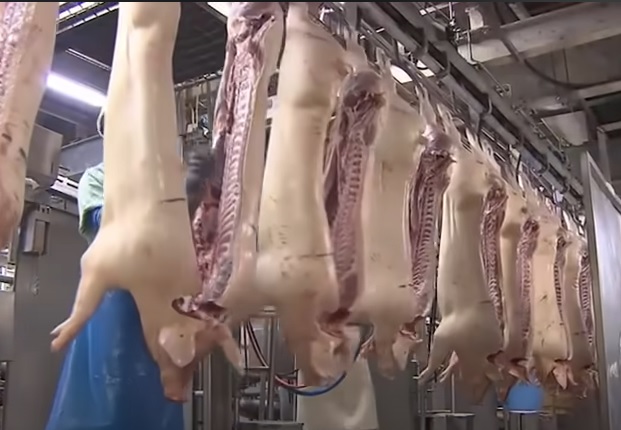In Chinese culture, pigs indicate wealth, success, productivity, and virility but even a high-rise pig farm can affect the animals. The pig is among the 12 signs of the Chinese zodiac and people born under that sign are believed to be hardworking, compassionate, and generous. Poems, stories, and songs celebrate them.
In many parts of the world, the rise in oil prices makes the price of everything else goes up. In China, a price increase in pork meat makes the price of everything skyrocket.
During Mao Zedong’s rule from 1949-76, meat was a rare luxury. However, in the late 1970s, pork demand rose by an average of 5.7% every year, until 2014 as the flourishing economy permitted millions of people to afford to eat meat more often.
‘China pig skyscraper’ today
Currently, the Chinese-to-pigs relationship has changed. People are eating more and more pork and they are now living at a distance from the pigs. Unlike before when the animals are mostly contained in walled structures within rural areas, hidden from the view of urbanites who dine on swine. Whether fresh, processed, or packaged pork, this is now widely available but far more visible than the pigs that produce it.
The modern pig has become a meat machine and pork production becomes a big business. China boasts the world’s largest pork-processing company, the WH Group, in addition to a multitude of vertically unified and internationally viable agribusiness firms. The country imports close to 70% of the worldwide soybean trade, primarily to feed its hogs, and has a world-leading soybean-crushing industry. In China today, it is more appropriate to say the pig is a “pork factory on four legs.”
China leads in eating pork
When it comes to pork consumption, China leads the world. The average Chinese person consumes close to 40 kilograms of pork per year and consumes half of all the pork in the world.
As a result of increased wealth and the growing hog industry within the agricultural segment, pork has become increasingly available to ordinary Chinese households. In 2020, nearly 42 million metric tons of pork had been served on dining tables in China. With lesser than 20% of the world’s population, the Chinese accounted for 40% of worldwide pork consumption.
As pork is such a major contributing aspect in propelling the country’s inflation rate, some have even named China’s Consumer Price Index the “China Pork Index” because of its enormous impact on inflation.
High-rise for pigs
On the southern outskirts of Ezhou, a city in central China’s Hubei province, a giant apartment-style building stands tall overlooking the main road. But it is not for office workers or families. At 26 floors, it is by far the biggest single-building pig farm in the world, with a capacity to slaughter 1.2 million pigs a year.
This is China’s answer to its voracious demand for pork.
The new skyscraper-sized farm began production at the start of October when the company behind the facility –

– admitted its first 3,700 sows into the farm.
According to statements on the company’s official WeChat account, the pig farm has two buildings. Behind the operational site, an identical-looking building of equal scale is nearing completion. When fully running, they will provide a combined area of 800,000 sq meters of space, with the capacity for 650,000 animals.
The 4bn yuan (£473m) farm has gas, temperature, and ventilation-controlled conditions, with animals fed through more than 30,000 automatic feeding spots at the click of a button in a central control room.
Rules at the China pig skyscraper
The company is also attempting to set up a circular production model, including a high-temperature anaerobic (non-oxygen dependent) fermentation unit that could produce up to 120,000 cubic meters of biogas per day from manure. The treated waste as biogas can be used for power generation and heating water inside the farm. Workers will be required to go through multiple rounds of disinfection and testing before being given clearance to enter, and won’t be able to leave the site until their next break – reportedly once a week.
A farmer residing in the village across from the farm said “It’s unfathomable.” The farmer is anxious about the farm’s proximity because he believes that there will be an odor issue when it is fully operational.
“About 30 years ago when I was raising pigs, we would only have two or three in our backyard pigsty. I’ve heard pigs raised in these farms can be ready for sale in a few months, and back in the day, it would take us about a year to raise one. But I think as technology advances, this will be the trend in the future,” he said in a statement to The Guardian.
A policy statement was released in 2019 stating that China’s Ministry of Agriculture and Rural Affairs is allowing the construction of high-rise breeding facilities. Such was an announcement welcomed by investors, including Kingkey Smart Agriculture, which has reportedly said the high-rise production model is more efficient, bio-secure, and environmentally friendly.
“Compared with traditional breeding methods, high-rise pig farms are more intelligent, with a high level of automation and biosafety. At the same time, it has the advantage of saving land resources,” said Zhu Zengyong, a professor at the Institute of Animal Science of the Chinese Academy of Agricultural Sciences, who said their popularity had risen after the ASF outbreak.
With these high-rise pig farms becoming popular, the millions of pigs in China must be “feeling” more and more terrified, don’t you think?
Read More News:

